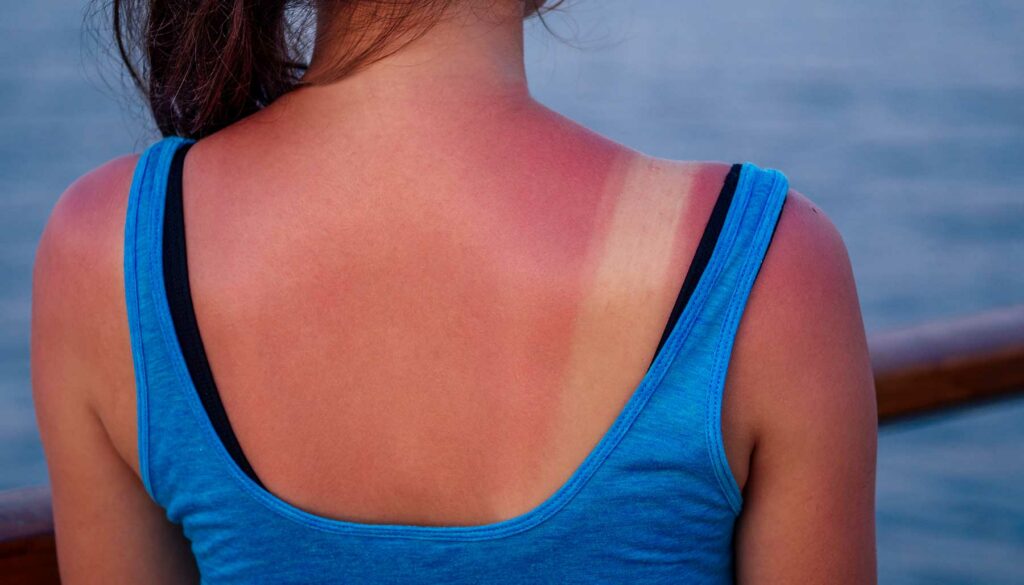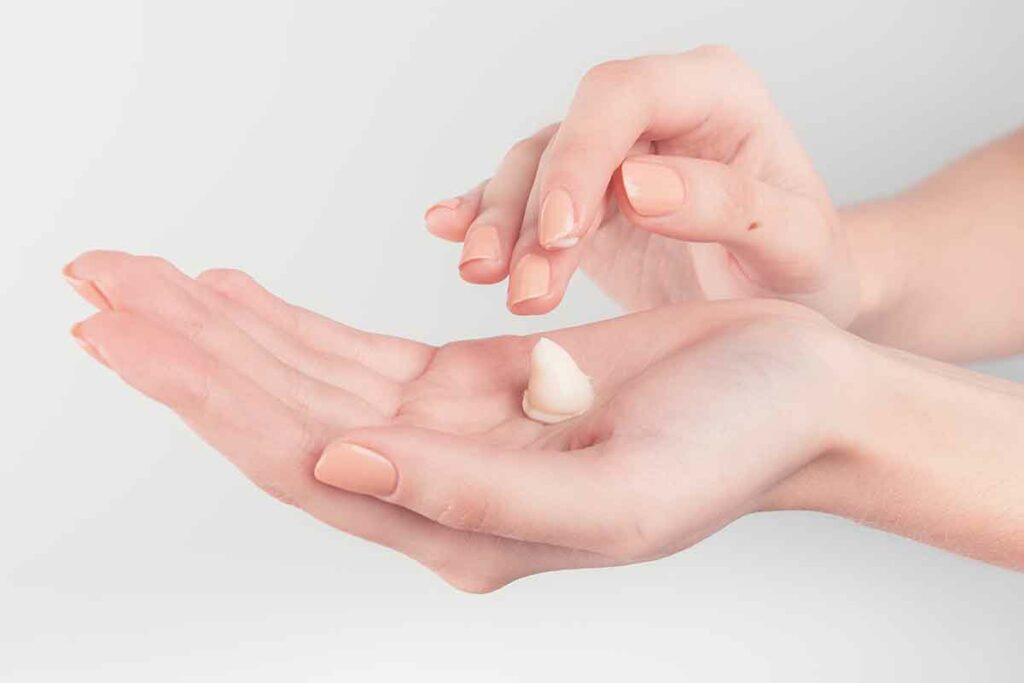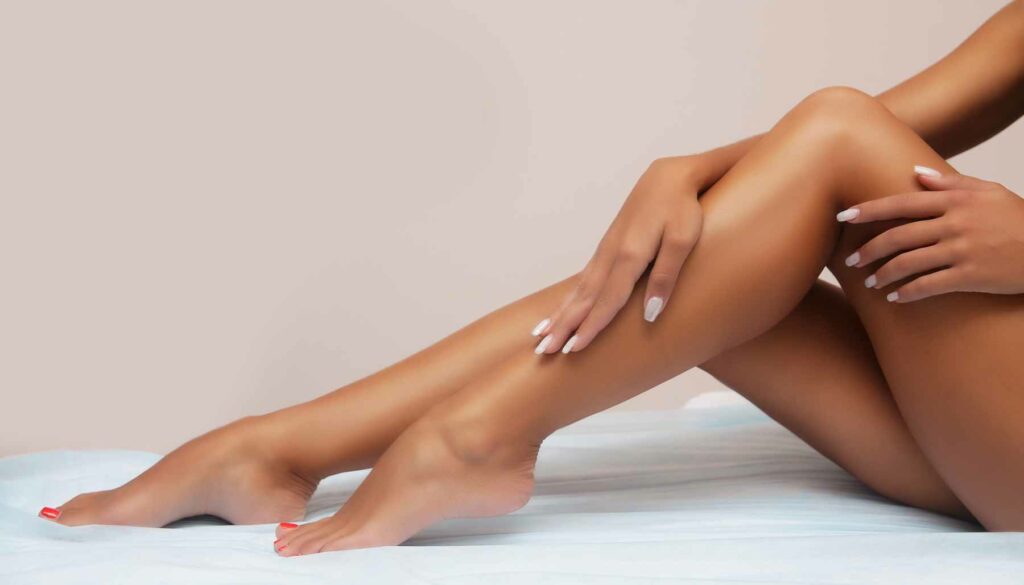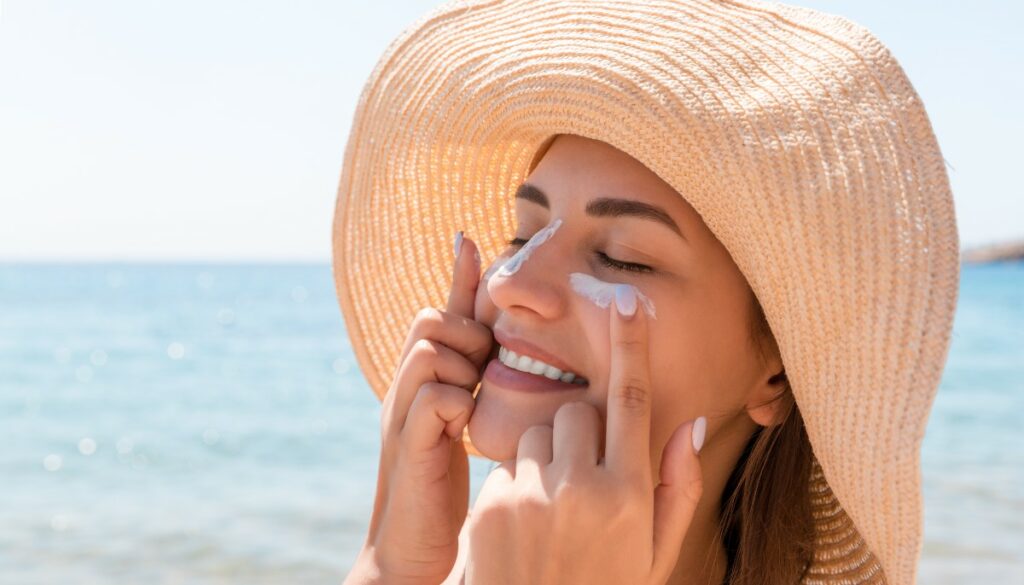If we want that fresh-from-vacay glow, we all know to reach for a sunless tanner. No more outdoor or indoor tanning, please! But have you ever wondered exactly how those sunless tanning products work? How do they produce a sunkissed glow, without any sunshine?
Okay, before we dive into the basics of how self-tanners darken your skin, I need to make sure everyone knows the real dangers of tanning. This is going to be important when we compare traditional tanning with sunless tanning products.
Every time we step outside into the sunshine, our skin is getting beat up by harmful ultraviolet (UV) rays. There’s no way of avoiding it. UV radiation is just part of the energy produced by the sun.

There are two types of UV light that we need to protect against: Ultraviolet A (or UVA) and Ultraviolet B (or UVB). Let’s take a look at the difference between the two.
UVA Rays Versus UVB Rays: What’s the Difference?

UVA rays have a longer wavelength and penetrate deeper into the skin. When you get a tan, it’s these longer wavelength UVA rays that affect the deepest layer of the epidermis. UVA radiation is more abundant than UVB rays. In fact, UVA accounts for up to 95 percent of UV radiation out there. This is concerning because UVA rays are associated with skin aging and other long-term skin changes. These are the ones that give you visible signs of aging, like wrinkles.
UVB rays have a shorter wavelength, so they don’t penetrate as deep as those UVA rays. That means they are mostly absorbed by the outermost layer of the skin. UVB rays are associated with skin redness, burning, inflammation, blisters, and other more immediate issues.

Here’s the kicker, though: unprotected exposure to UV radiation from the sun does some serious harm, outside of burns and wrinkles. They damage the DNA in skin cells. And while our bodies can repair some of the damage done to skin cells, it can’t repair all of the damage. Eventually, all that damage starts building up over time.
After enough damage, it starts to produce mutations and causes cells to grow out of control, leading to skin cancer. The majority of both melanomas and nonmelanoma skin cancers are associated with exposure to UV radiation from the sun.
And while we’re specifically talking about skin here, it’s important to remember that unprotected exposure to UVA and UVB rays can also cause eye damage, as well. This exposure can lead to cataracts, growths, corneal damage, vision loss, cancer, and more. Protecting your eyes from UV damage is just as important as protecting your skin.
How Sunless Tanners Actually Work
Okay, so to skip all that skin damage and still get a summer glow, it’s time to reach for the self-tanning lotion! But, have you ever asked yourself how those sunless tanners actually work? How does it darken your skin without any sunlight?

Whether it’s a spray, a lotion, a fancy airbrush tan, or a professional spray booth, most sunless tanners take advantage of the same active ingredient to produce your golden glow. That ingredient is called dihydroxyacetone, or DHA, which is a colorless sugar compound primarily derived from sugar cane and sugar beets. DHA reacts with amino acids in the skin, and it produces that browner hue.
The reaction only affects the dead skin cells of the outermost layer of the epidermis. That’s why sunless tanners usually only last for about five to seven days after application. This is also why you should exfoliate really well before applying your self-tanner. Any buildup of dry and dead skin cells will react with DHA more, leaving you with dark, uneven patches.
Is DHA Safe for Skin?
I know it sounds kind of scary when we talk about something called dihydroxyacetone having chemical reactions with the amino acids in our skin. It might leave you wondering if this ingredient is safe for your skin, especially in a product that you’re supposed to reapply at least once a week to maintain your golden glow.

DHA-based sunless tanners have been around for quite a while now. Although the reaction with skin was first discovered in the 1920s, the first commercialized self-tanning lotions were introduced in the 1940s. The FDA approved DHA for cosmetic use in the 1970s, and we haven’t looked back. Many dermatologists over the years have assured people that DHA has been shown to be safe when applied topically.
This, of course, doesn’t account for an allergy. It is possible to have an allergic reaction to DHA or any number of other ingredients you may find in sunless tanners.
There have been studies to look at the connection between DHA and free radical damage. The increased susceptibility is tied to the skin being exposed to UV rays after applying a DHA-based tanner. To combat this, apply your self-tanner at night. You can also use an antioxidant with your DHA self-tanner to prevent free radical damage.
Getting a self-tanning lotion may be safer than a spray tan, though. The product isn’t meant to be inhaled, but that’s the risk when you’re spraying it. Aside from the DHA itself, there are other ingredients and fragrances that may be present, too.
And if you were wondering about new “DHA-free” self-tanners that have hit the market, they’re essentially the same. These products rely on an active ingredient called erythrulose, which works exactly the same way as DHA: by reacting with amino acids in the outermost layer of skin. This kind of self-tanner is supposedly less drying to the skin and produces a warmer, redder tone. The color takes longer to develop than DHA tanners and may be lighter in color.
It’s Definitely Safer Than a Real Tan
Despite these concerns, we can all agree that a sunless tanning product, DHA or not, is infinitely safer than getting a tan caused by UV radiation. As I mentioned, UVA and UVB rays will wreak havoc on your skin, leaving both temporary and long-term damage. Wrinkles and burns aside, it will absolutely put you at risk for developing skin cancer – including the deadliest type, melanoma.
Getting a Sunless Glow at Home
It’s lovely to get a spray tan professionally. It goes quickly, You don’t have to worry about missing that one spot on your back, and really, you don’t have to do anything except stand there. However, it’s entirely possible (and more affordable!) to get a good sunless tan in the comfort of your own home.
Related: The Best Self-Tanners to Get That Sunkissed Glow

For the best results, you’ll want to follow the specific product’s given instructions. These can vary depending on the method of application, and how long it takes for the product to dry. Of course, there are some general tips to help get your best sunless tan at home.
- Exfoliate: I know I mentioned it briefly, but you have to exfoliate really well before applying a self-tanner. Because it works by interacting with the very top layer of dead skin cells, any buildup will cause an uneven, patchy appearance.
- Pay Special Attention to Joints: Your knees, elbows, and ankles tend to be drier than other parts of your body. That dry skin can absorb more of the product than the rest of your surrounding skin, causing those areas to look darker. If this is a concern, you can use a damp towel to wipe away some of the product from these areas.
- Wash Your Hands: Give your hands a good wash right after application. Much like the rest of your skin, your palms will react with the product. The longer you wait to wash them, the longer your skin has to react. No one wants brown, streaky palms.
- Wait for It to Dry: It might seem weird to hang around for a long time without getting dressed, but the product needs to dry before you do anything. After applying the sunless tanner in a thin, even layer, wait at least fifteen minutes before putting on clothes. Not only will this help ensure you don’t wind up with streaky or splotchy skin, but it’ll probably also help prevent clothes from turning brown.
You Still Need Sunscreen!

Repeat after me: fake tans do not provide any protection from the sun’s UV rays! While it’s true that darker skin is less susceptible to damage from UV radiation (but still susceptible so please still wear your sunscreen!!!), this logic doesn’t apply to skin that’s been darkened with a sunless tanner.
Always continue to utilize protective clothing, hats, and sunscreen along with DHA-based tanning products. When possible, seek out shade, and don’t forget your sunglasses. When choosing a sunscreen, reach for something that is SPF 30 or higher. Always look for a sunscreen that is labeled broad-spectrum, too, because this means it blocks both UVA and UVB rays.
It doesn’t matter if it’s cloudy outside, or if it’s a cold January day. I don’t care if you’re going to be indoors for a big chunk of your day. You need to slather on that broad-spectrum sunscreen every day. UV radiation is still all around us in the dead of winter, and UVA rays can penetrate windows.













